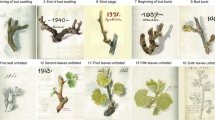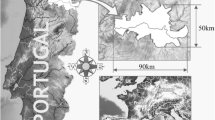Abstract
While the climate of Western Europe has been deeply affected by the abrupt climate change that took place in the late ‘1980s of the twentieth century, a similar signal is detected only few years later, in 1994, in Georgia. Grapevine phenology is deeply influenced by climate and this paper aimed to analyze how phenological timing changed before and after the climatic change of 1994. Availability of thermal resources in the two climatic phases for the five altitudinal belts in the 0–1250-m range was analyzed. A phenological dataset gathered in two experimental sites during the period 2012–2014, and a suitable thermal dataset was used to calibrate a phenological model based on the normal approach and able to describe BBCH phenological stages 61 (beginning of flowering), 71 (fruit set), and 81 (veraison). Calibration was performed for four relevant Georgian varieties (Mtsvane Kakhuri, Rkatsiteli, Ojaleshi, and Saperavi). The model validation was performed on an independent 3-year dataset gathered in Gorizia (Italy). Furthermore, in the case of variety Rkatsiteli, the model was applied to the 1974–2013 thermal time series in order to obtain phenological maps of the Georgian territory. Results show that after the climate change of 1994, Rkatsiteli showed an advance, more relevant at higher altitudes where the whole increase of thermal resource was effectively translated in phenological advance. For instance the average advance of veraison was 5.9 days for 250–500 m asl belt and 18.1 days for 750–1000 m asl). On the other hand, at lower altitudes, phenological advance was depleted by superoptimal temperatures. As a final result, some suggestions for the adaptation of viticultural practices to the current climatic phase are provided.










Similar content being viewed by others
References
Alexander MA, Kilbourne KH, Nye JA (2014) Climate variability during warm and cold phases of the Atlantic Multidecadal oscillation (AMO) 1871–2008. J Mar Syst 133:14–26
Bai J, Perron P (2003) Computation and analysis of multiple structural change models. J Appl Econ 18:1–22
Beck C, Jacobeit J, Jones PD (2007) Frequency and within-type variations of large-scale circulation types and their effects on low-frequency climate variability in Central Europe since 1780. Int J Climatol 27:473–491
Bock A, Sparks T, Estrella N, Menzel A (2011) Changes in the phenology and composition of wine from Franconia Germany. Clim Res 50:69–81
Chkhartishvili N, Maghradze D (2012) Viticulture and winemaking in Georgia. In (Maghradze D, Rustioni L, Scienza A, Turok J, Failla O, Eds.) (2012) Caucasus and Northern Black Sea Region Ampelography. Vitis, 52, Special Issue, JKI - Julius Kühn-Institut, ISBN 9783930037889: 169–176.
Chuine I, Yiou P, Viovy N, Seguin B, Daux V, Ladurie EL (2004) Historical phenology: grape ripening as a past climate indicator. Nature 432:289–290
De Lorenzis G, Chipashvili R, Failla O, Maghradze D (2015) Study of genetic variability in Vitis vinifera L. Germplasm by high-throughput Vitis18kSNP array: the case of Georgian genetic resources. BMC Plant Biol 15(1):154. doi:10.1186/s12870-015-0510-9
Duchene E, Schneider C (2005) Grapevine and climatic changes: a glance at the situation in Alsace. Agron Sustain Dev 25:93–99
European Environmental Agency, 2016. Global average air temperature anomalies (1850 to 2013) in degrees Celsius (°C) relative to a pre-industrial baseline period, http://www.eea.europa.eu/data-and-maps/figures/global-annual-average-temperature-deviations-1850-2007-relative-to-the-1850-1899-average-in-oc-the-lines-refer-to-10-year-moving-average-the-bars-to-the-annual-land-and-ocean-global-average-9. Accessed 15 August 2016.
Failla O (2015) East-west collaboration for grapevine diversity exploration and mobilization of adaptive traits for breeding: a four years story. Vitis 54(Special Issue):1–4
FAO (2016) Faostat, http://fenix.fao.org/faostat/beta/en/#data/QC. Accessed 13 Aug 2016.
Fraga H, Santos JA, Moutinho-Pereira J, Carlos C, Silvestre J, Eiras-Dias J, Mota T, Malheiro AC (2015) Statistical modelling of grapevine phenology in Portuguese wine regions: observed trends and climate change projections. J Agric Sci:1–17. doi:10.1017/S0021859615000933
Georgian institute of Statistics (2015) Agricultural statistics, www.geostat.ge. Accessed 10 december 2015
Grifoni D, Mancini M, Maracchi G, Orlandini S, Zipoli G (2006) Analysis of Italian wine quality using freely available meteorological information. American Journal of Enology and Viticulture September 57:339–346
Imazio S, Maghradze D, De Lorenzis G, Bacilieri R, Laucou V, This P, Scienza A, Failla O (2013) From the cradle of grapevine domestication: molecular overview and description of Georgian grapevine (Vitis vinifera L.) germplasm. Tree Genetics and Genomes 9:641–658
Jones G V (2007) Climate change: observations, projections, and general implications for viticulture and wine production. Economics Department, Whitman College, working paper n. 7, 17 pp.
Ketskhoveli N, Ramishvili M, Tabidze D (1960) Ampelography of Georgia. Georgian Academy of Science, Tbilisi (In Georgian and Russian)
Kilbourne KH (2014) A Paleoclimate perspective on Atlantic Multidecadal variability. J Mar Syst 133:4–13
Knudsen MF, Seidenkrantz M, Jacobsen BH, Kuijpers A (2011) Tracking the Atlantic Multidecadal Oscillation through the last 8,000 years. Nat Commun 2:178
Köppen W, Geiger G (1936) Handbuch der Klimatologie, edited by: Köppen, W. and Geiger, G., 1. C. Gebr, Borntraeger, 1–44.
Köse B (2015) Phenology and Ripening of Vitis vinifera L. and Vitis labrusca L. Varieties in the maritime climate of Samsun in Turkey’s Black Sea Region, S. Afr. J. Enol. Vitic., Vol. 35, n 1, 2014 90–102
Labbé T, Gaveau F (2013) Les datees de vendange à Beaune (1371–2010). Analyse et données d’une nouvelle série vendémiologique, Revue historique, n° 666, 2013/2: 333–367
Maghradze D, Rustioni L, Scienza A, Failla O (2012a) Phenological diversity of Georgian grapevine cultivars in northern Italy. Journal of the American Pomological Society 66(2):56–67
Maghradze D, Rustioni L, Turok J, Scienza, A, Failla O (2012b) Caucasus and Northern Black Sea Region Ampelography, VITIS, Journal of Grapevine Research.
Mariani L, Alilla R, Cola G, Dal Monte G, Epifani C, Puppi G, Failla O (2013) IPHEN—a real-time network for phenological monitoring and modelling in Italy. Int J Biometeorol. doi:10.10007/s00484-012-0615-x: 1-13
Mariani L, Cola G, Bulgari R, Ferrante A, Martinetti L (2016) Space and time variability of heating requirements for greenhouse tomato production in the Euro-Mediterranean area. Sci Total Environ 562:834–844
Mariani L, Parisi S, Cola G, Failla O (2012) Climate change in Europe and effects on thermal resources for crops. Int J Biometeorol 56:1123–1134
Mariani L, Parisi S, Failla O, Cola G, Zoia G, Bonardi L (2009) Tirano (1624–1930): A long time series of harvest dates for grapevine [Tirano (1624–1930): Una lunga serie storica di date di vendemmia]. RIVISTA ITALIANA DI AGROMETEOROLOGIA, vol. 1, p. 7–16, ISSN: 1824–8705
Mc Carthy G D, Haigh I D, Hirschi J J M , Grsit J P, Smeed D A (2015) Ocean impact on decadal Atlantic climate variability revealed by sea-level observations. Nature, 521, 508Ð510, 10.1038/nature14491.
Meier U (ed) (2001) Growth stages of mono-and dicotyledonous plants, second edition, BBCH Monograph, Federal Biological Research Centre for Agriculture and Forestry: 158 pp
Parisi SG, Antoniazzi MM, Cola G, Lovat L, Mariani L, Moreale G, Zoltan K, Calò A (2014) Spring thermal resources for grapevine in Koszeg (Hungary) deduced from a very long pictorial time series (1740 – 2009). Clim Chang. doi:10.1007/s10584-014-1220-2
Parton WJ, Logan JA (1981) A model for diurnal variation in soil and air temperature. Agric Meteorol 23:205–216
Rustioni L, Cola G, Fiori S, et al. (2014b) Application of standard methods for the grapevine (Vitis vinifera l.) phenotypic diversity exploration: phenological traits. Acta Hortic 1032:253–260
Rustioni L, Maghradze D, Popescu CF, et al. (2014a) First results of the European grapevine collections’ collaborative network: validation of a standard eno-carpological phenotyping method. Vitis 53:219–226
Santos JA, Malheiro AC, Pinto JG, Jones GV (2012) Macroclimate and viticultural zoning in Europe: observed trends and atmospheric forcing,. Res Clim 51:89–103
Tomasi D, Jones GV, Giust M, Lovat L, Gaiotti F (2011) Grapevine phenology and climate change: relationships and trends in the Veneto region of Italy for 1964-2009. Am J Enol Vitic 62(3):329–339
Zohary D, Hopf M (2000) Domestication of plants in the Old World, 3rd edn. Oxford University Press, p. 316
Acknowledgments
We would like to express our sincere thanks to all the people involved in the COST ACTION FA1003–Grapenet: East-West Collaboration for Grapevine Diversity Exploration and Mobilization of Adaptive Traits for Breeding, to the Hydrometeorology Department of the National Environmental Agency of Georgia and to the Georgian National Wine Agency.
Author information
Authors and Affiliations
Corresponding author
Additional information
An erratum to this article is available at http://dx.doi.org/10.1007/s00484-016-1289-6.
Electronic supplementary material
ESM 1
(PDF 216 kb)
Rights and permissions
About this article
Cite this article
Cola, G., Failla, O., Maghradze, D. et al. Grapevine phenology and climate change in Georgia. Int J Biometeorol 61, 761–773 (2017). https://doi.org/10.1007/s00484-016-1241-9
Received:
Revised:
Accepted:
Published:
Issue Date:
DOI: https://doi.org/10.1007/s00484-016-1241-9




